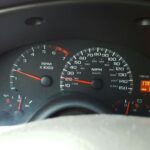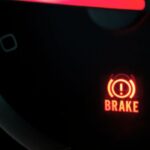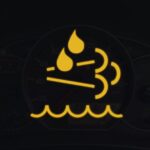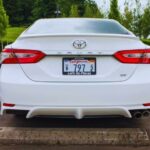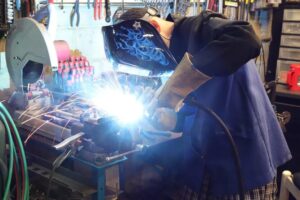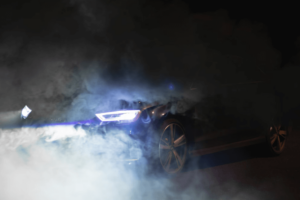If you see “DRL” on your dash, you may be wondering what this means. DRL stands for a daytime running lamp or daytime running light. What is the DRL light?
DRL lights are lights located at the front of vehicles, usually below the headlamps. DRL lights turn on automatically when the car is put in gear or when releasing the handbrakes. They also send warnings to the other motorists that the car is active and in motion.
Read on to learn more about DRL lights and what they are for.
What Is a DRL Light?

DRL lights are lights installed at the front of the vehicle, either above or below the headlamps. DRL lights turn on automatically when you turn the key in the ignition. However, in some cars, they turn on when you put the car in gear or release the handbrake.
The DRL light is usually a strip of LED lights installed inside the headlamp enclosure. Since they do not have that much power, they will not be as bright as your car’s headlamps. However, note that their purpose is not for illuminating the road ahead. Instead, they are for letting other motorists know that you are on the road.
The purpose of a DRL light is to make your vehicle more visible on the road during the daytime. At night, cars already have headlights and taillights to make them more visible at night. However, during the day, the ambient light is the only thing that they can rely on.
Cars that have DRL are more visible when you are looking at the rearview and side mirrors. Therefore, they are significantly more visible than vehicles without DRL.
When other cars are aware of your position relative to them, it significantly decreases the chances of blind spot collisions. It would also make it safer to switch lanes when the other cars on the road know where you are.
DRLs also make your car more visible to pedestrians. Cars with DRLs are easier to see through peripheral vision. As a result, it lowers the likelihood of a pedestrian suddenly stepping in front of your moving car.
When Did DRL Lights Start Appearing in Cars?
DRL lights are not new. They have been around since the 70s, when they were first introduced as a safety measure for cars. However, the usefulness of these safety features is still a topic of hot debate among automotive experts until now.
Daytime running lights (also called daytime running lamps) first became popular in countries in the upper Northern hemisphere, almost always overcast. This is particularly true during the winter months.
Norway, Iceland, Sweden, Denmark, and Canada were some of the first countries to require DRL lights to come standard in all road vehicles. In addition, some German brands were among the first to have DRL light (Volkswagen). Studies conducted in these countries since the 1970s showed that DRLs reduce vehicular accidents significantly.
However, in other countries, DRL lights are not quite as popular. Some have even met the feature with resistance. For instance, General Motors pushed to make DRLs standard in all US road vehicles. This decision received a lot of criticism.
The issue back then was that there were no restrictions in place regarding the DRL light. This meant that some of them were too bright. Once regulations were set in place, cars with DRL lights were consequently allowed on US roads.
There were also issues with DRL lights when they were first implemented in countries with tropical climates. A prominent issue is that which surfaced in Malaysia. Back then, daylight running lights ran so hotly. When coupled with the intense heat of the tropical sun, they were enough to warp the headlamp enclosures.
Fortunately, the manufacturers honored the warranties and replaced all the faulty headlamps. However, this time, they did not connect the DRLs.
Modern DRL lights are now LEDs instead of low-powered halogens. This means they hardly produce any heat at all. Moreover, they do not draw quite as much power from the batteries. Presently, DRL lights are already required features in all new vehicles released in the UK and most parts of Europe. On the other hand, in the US, it is optional but highly recommended.
Flashing Brake Lights – What Are They? Are They Legal? – Car or Motorcycle
DRL Light Issues

Although DRL lights are proven safety features that significantly reduce vehicular accidents, some people still have complaints. Here are some of the more valid claims of people who oppose the use of DRL lights:
1. Increase Glare
Headlight glare, both from oncoming and following vehicles, is the issue behind most of the complaints. This is particularly true with GM vehicles that presumably have brighter DRLs compared to the others. The glare is supposedly so bright sometimes that drivers are forced to use sunglasses even during low-light conditions.
Also, the glare may easily aggravate some motorists, causing them to lose their tempers while driving, leading to road rage. Some people said that the glare from DRL lights from vehicles behind them is sometimes too much. It is to the point of misaligning their rearview mirrors, defeating their purpose, and increasing the risk of accidents.
2. Obscure the Turn Signals
Many people also complain that a DRL light reduces, and even obscures, the visibility of turn signals. They claim that some vehicles’ turn signals are not visible during the daylight, to begin with. Having a DRL placed close beside the signals, therefore, can only make them even less conspicuous.
3. Make the Roads Look Cluttered
Some people also complained about the clutter that DRL lights often cause on the road. Instead of simply making vehicles more conspicuous, multiple vehicles with their DRL lights make the roads look cluttered and confusing.
4. Reduce the Conspicuity of Other Road Users
Some people claim that their visual attention is obstructed by vehicles with DRL lights on the roadway. It can be disadvantageous for pedestrians, cyclists, and other road users without DRLs.
Some motorcyclists feel like the DRL light on cars decreases the visibility of their smaller vehicles, even if they have DRL lights themselves. They believe that the widespread use of the DRL light will eliminate the use of the DRL light on their motorcycles.
5. Distorts People’s Distance Perception
Some drivers complained that DRL lights distort their distance perception. However, they vary depending on who you ask. Some people complain that the DRL lights make oncoming traffic look closer than they are.
Others complain about the opposite happening. The only consistent thing is that DRLs supposedly distort the driver’s distance perception. It may also impair their decision-making capabilities.
6. Reduce the Visibility of Emergency Vehicles
The flashing lightbars of emergency vehicles allow them to be visible even during daytime hours. The lights serve to distinguish them from the regular vehicles on the road. This differentiation diminishes when they are among a group of vehicles equipped with DRL lights.
It is also the concern of convoys of slow-moving vehicles, like funeral processions. The reason is that they do not move in sync with the normal flow of traffic.
7. Discourage Motorists from Using Their Standard Headlamps
Because a DRL light provides the driver with some degree of illumination, they would sometimes forget to turn on their actual headlamps. It means that they would decrease their visibility come nighttime. It is not just for oncoming vehicles but also from those following behind them. The reason is that the taillights will not turn on when the DRLs are the only ones functioning.
Although it seems like most of these complaints are valid, there is not enough evidence to support their claims. The fact remains that DRL lights help in reducing accidents significantly. Also, changes in modern DRL lights invalidate some of the points raised by those opposed to them.
How Do You Install Aftermarket DRL lights?

If your car does not have a DRL, as mentioned earlier, you can install an aftermarket kit on it. Now, the degree of difficulty will depend on the make and model of the car. It will not depend on the electrical wiring but the access to the headlamp enclosure. Many people complain about the aftermarket Honda DRL light kits because accessing the headlight enclosures can be quite difficult.
This is a relatively easy project that requires no drilling and no soldering whatsoever. If you can easily access any location on your car you want the DRL lights to be, then the process will only take less than an hour:
Step 1
Make sure that the car engine is off and the engine is cool. It makes the entire process easier since the car will not be warm. Also, ensure that you take the key out of the ignition to prevent accidentally shocking yourself.
Step 2
Mount the LED strip on the headlamp enclosure. The nice thing about modern daytime running lamps is you do not need to install them inside the headlamp within the enclosure. They already come with a heavy-duty adhesive strip and a weatherproof enclosure. Just mount them wherever you like on the outside edge of the headlamp.
Step 3
Once you are satisfied with the placement, run the wires towards the battery and fuse box. Find the ACC fuse in the fuse box. You can use the guide on the cover as a guide. Once you find the ACC fuse, remove it. Next, tap the red wires of the lights onto one of the blades, then reinsert the fuse.
Step 4
Take the black wires and then attach them to the negative terminal of the battery.
Step 5
Put the key into the ignition and turn it to the ACC position. This should turn on the daytime running lights. If one or both lights are not turning on, remove the key and check your connections.
Step 6 (optional)
If your aftermarket DRL lights come with a yellow wire, it means you can also connect it to the turn signals. Take out the turn signal bulb socket. You can take the whole thing off by pushing and twisting the socket to the left. Take the yellow wire and attach it to the positive terminal of the bulb socket.
If you got the DRL and turn signal combo, the light will turn yellow. You can then expect the lights to blink in the direction you are turning.
DRL Lights FAQs
Can You Have a DRL Light Installed?
If your car did not come with daytime running lights, there are aftermarket kits that you can install on your car. Unlike the old-fashioned DRL lights that were low-powered bulbs inside the headlight housing, the aftermarket lights use LED bulbs. It means the lights do not use a lot of power. They do not even generate a significant amount of heat.
You will only need a nominal amount of electrical knowledge to install modern aftermarket DRL lights. It will also take you only less than fifteen minutes per light.
How to Turn On DRL Lights? Can You Turn DRL Lights Off?
If your car came with supplemental daytime running lights, like the Volkswagen DRL light, you could turn it on by twisting the light switch on the steering to the “auto” position. This way, when you turn on the ignition, the DRL lights will also automatically turn on.
Now, if your car does not come with a DRL ON/OFF switch, you can’t turn off this feature unless you are willing to do some modifications with the headlamps. However, keep in mind that doing this kind of modification will permanently disable the auto headlamps in certain cars.
Conclusion – DRL: What Is It and How Does It Work?
Daytime Running Lights or DRLs refer to lights located in front of your vehicle. You can often see these lights above or below the headlamps. They turn on automatically when the engine is running. DRL lights serve to alert other cars of your presence. When cars are more visible, drivers will find it easier to avoid unintended collisions.
Although some people oppose the use of DRL lights, the fact remains that they help decrease collisions between road vehicles. Also, DRLs make pedestrians more aware of the vehicles around them. So if your car has a DRL function, make sure to turn it on.
Ensure that they also function properly. On the other hand, if your car does not have DRLs, consider having aftermarket kits installed. Your safety may depend on them.
Related reading:

![DRL Warning Light [What Does It Mean, Causes, and How to Fix] what does the drl warning light mean](https://roadsumo.com/wp-content/uploads/2022/04/what-does-the-drl-warning-light-mean-150x150.jpg)
